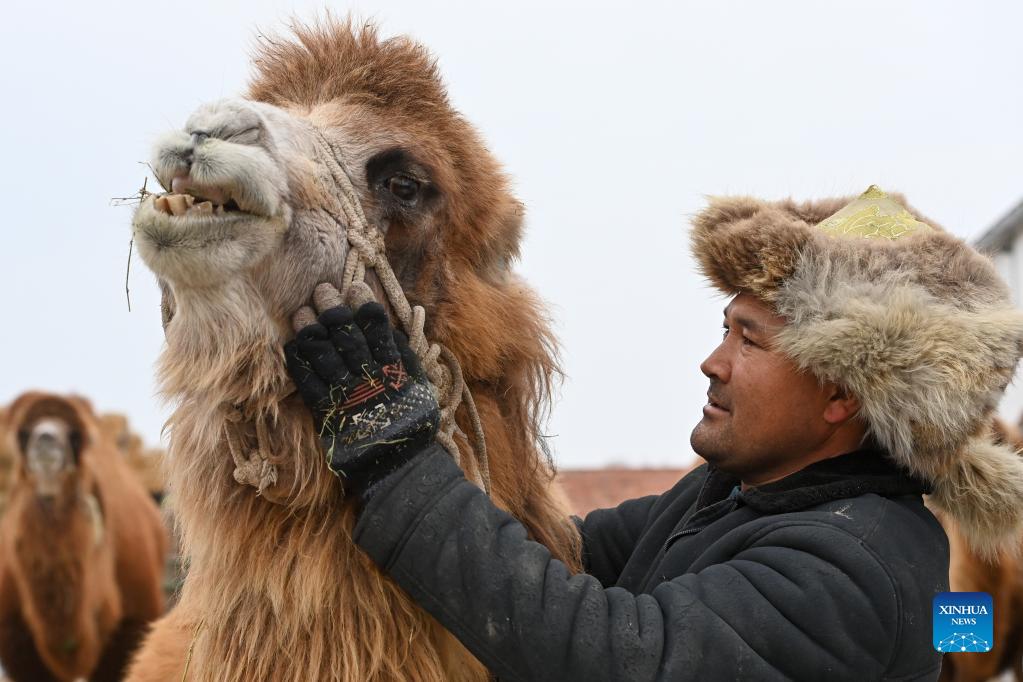
A breeder checks a camel in Fuhai County of Altay, northwest China's Xinjiang Uygur Autonomous Region, Nov. 26, 2021. Fuhai, located in north Xinjiang, is an important stock farming base in the region, with unique geographical and climatic conditions especially suitable for camel breeding. In recent years, camel breeding has developed into a pillar industry under promotion policy in Fuhai. By establishing camel milk cooperatives, individual herders here are accessing the dairy market through unified and stable sales channels. In 2021, the number of camels in the county has totaled 22,300, among which 6,470 are dairy camels with a daily milk output of 12,500 kilograms. (Xinhua/Ding Lei)
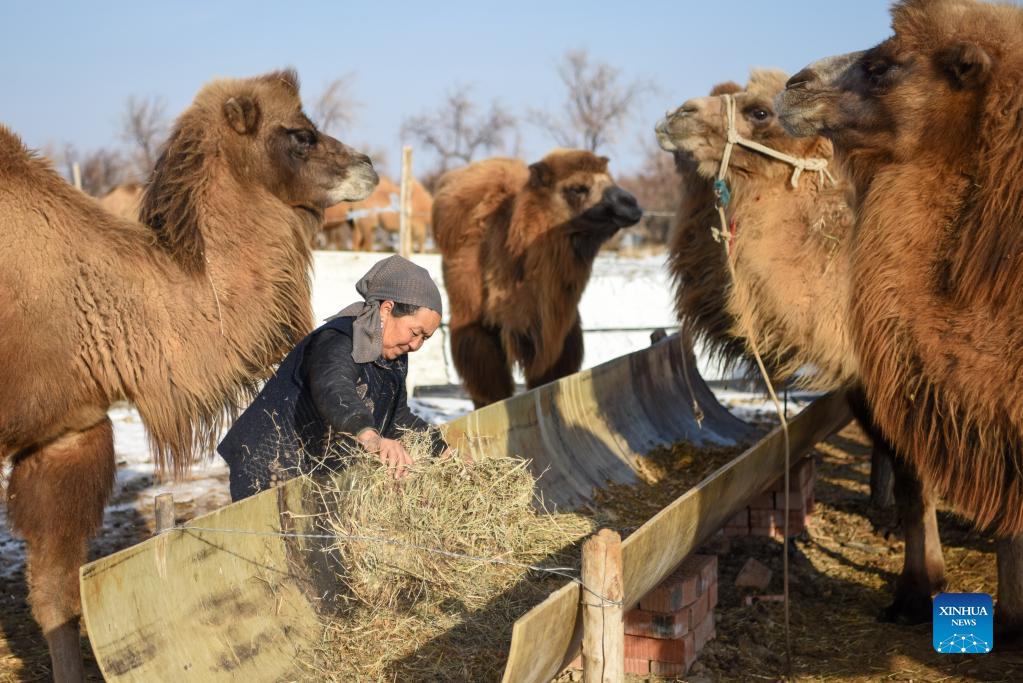
A breeder feeds camels with fodder in Fuhai County of Altay, northwest China's Xinjiang Uygur Autonomous Region, Nov. 25, 2021. Fuhai, located in north Xinjiang, is an important stock farming base in the region, with unique geographical and climatic conditions especially suitable for camel breeding. In recent years, camel breeding has developed into a pillar industry under promotion policy in Fuhai. By establishing camel milk cooperatives, individual herders here are accessing the dairy market through unified and stable sales channels. In 2021, the number of camels in the county has totaled 22,300, among which 6,470 are dairy camels with a daily milk output of 12,500 kilograms. (Xinhua/Ding Lei)
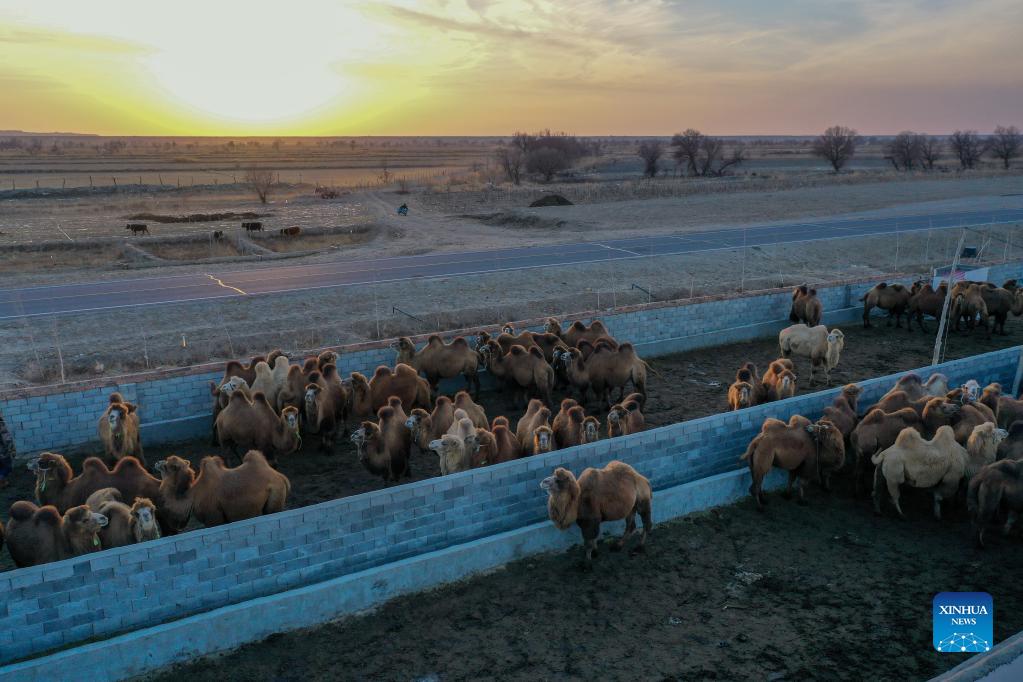
Aerial photo taken on Nov. 24, 2021 shows camels raised by a breeder in Fuhai County of Altay, northwest China's Xinjiang Uygur Autonomous Region. Fuhai, located in north Xinjiang, is an important stock farming base in the region, with unique geographical and climatic conditions especially suitable for camel breeding. In recent years, camel breeding has developed into a pillar industry under promotion policy in Fuhai. By establishing camel milk cooperatives, individual herders here are accessing the dairy market through unified and stable sales channels. In 2021, the number of camels in the county has totaled 22,300, among which 6,470 are dairy camels with a daily milk output of 12,500 kilograms. (Xinhua/Ding Lei)
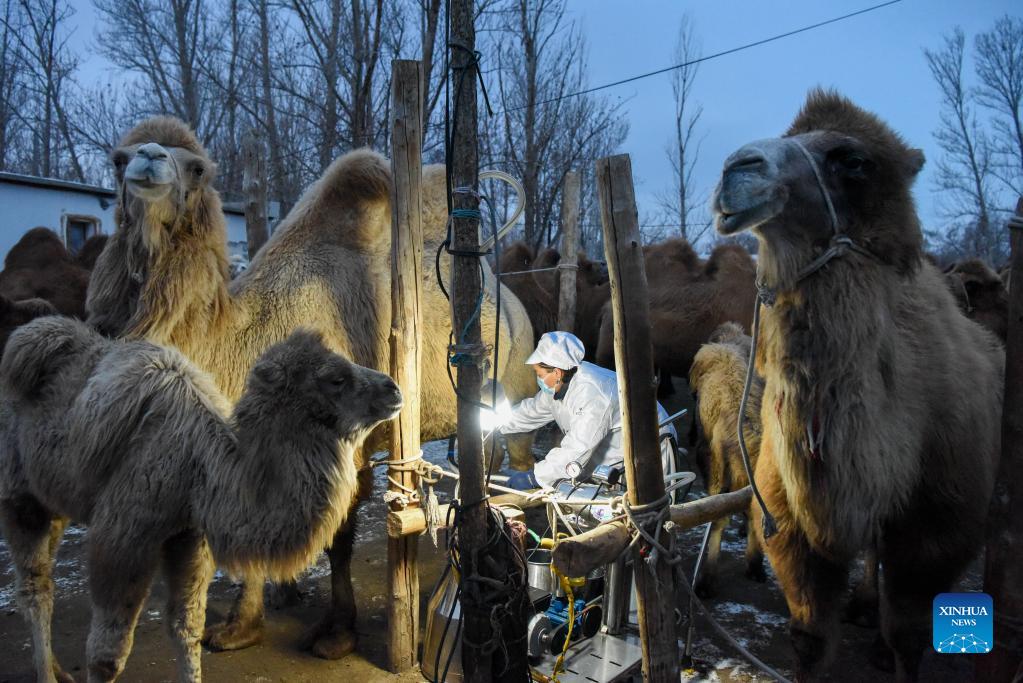
A camel breeder milks camels with automatic facilities in Fuhai County of Altay, northwest China's Xinjiang Uygur Autonomous Region, Nov. 26, 2021. Fuhai, located in north Xinjiang, is an important stock farming base in the region, with unique geographical and climatic conditions especially suitable for camel breeding. In recent years, camel breeding has developed into a pillar industry under promotion policy in Fuhai. By establishing camel milk cooperatives, individual herders here are accessing the dairy market through unified and stable sales channels. In 2021, the number of camels in the county has totaled 22,300, among which 6,470 are dairy camels with a daily milk output of 12,500 kilograms. (Xinhua/Ding Lei)
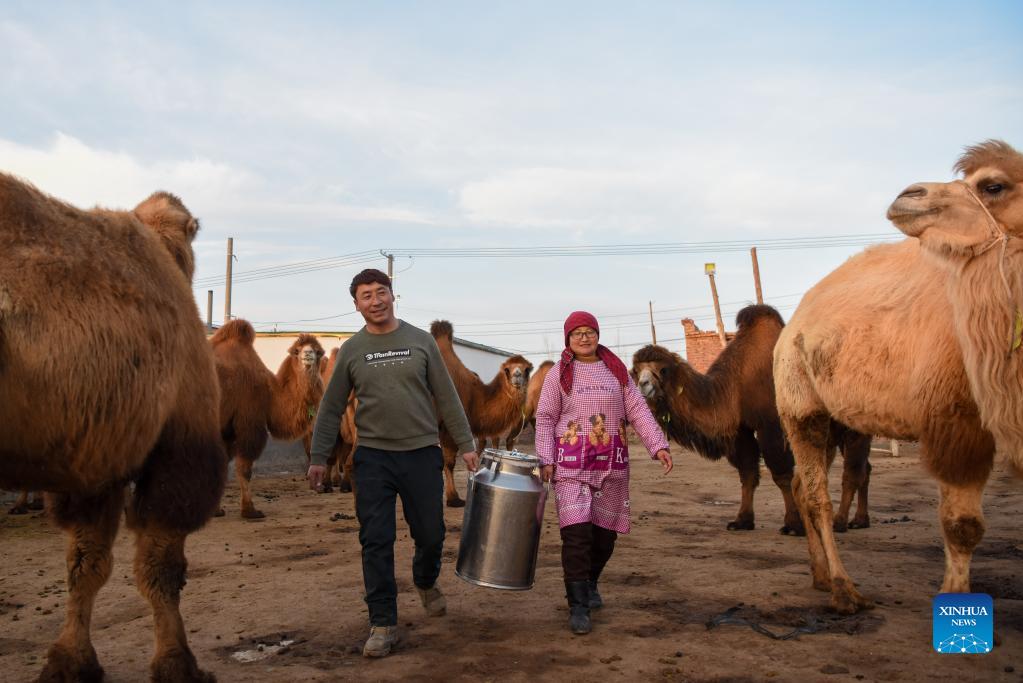
Breeders transfer fresh camel milk in Fuhai County of Altay, northwest China's Xinjiang Uygur Autonomous Region, Nov. 24, 2021. Fuhai, located in north Xinjiang, is an important stock farming base in the region, with unique geographical and climatic conditions especially suitable for camel breeding. In recent years, camel breeding has developed into a pillar industry under promotion policy in Fuhai. By establishing camel milk cooperatives, individual herders here are accessing the dairy market through unified and stable sales channels. In 2021, the number of camels in the county has totaled 22,300, among which 6,470 are dairy camels with a daily milk output of 12,500 kilograms. (Xinhua/Ding Lei)
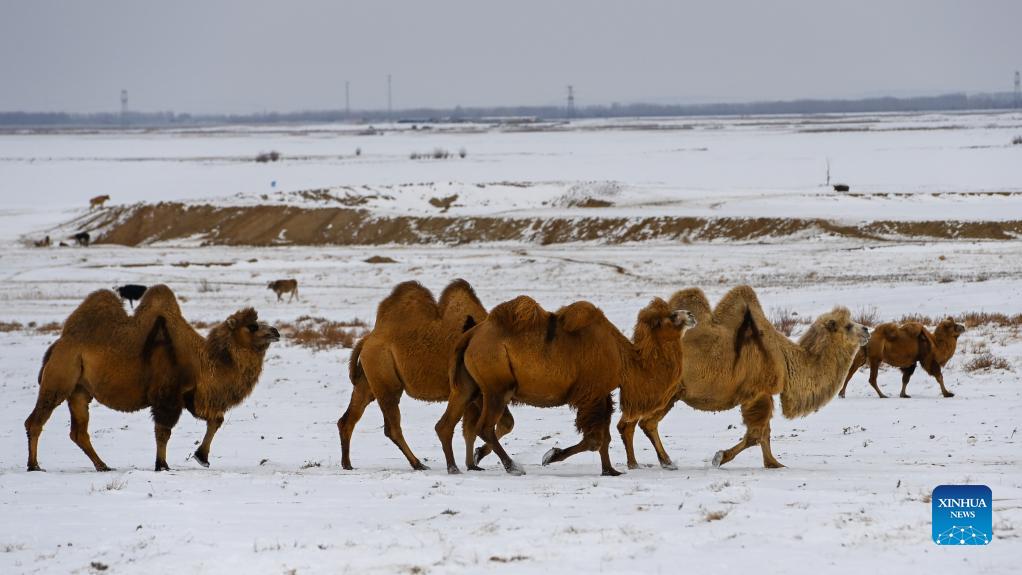
Camels forage on the pasture in Fuhai County of Altay, northwest China's Xinjiang Uygur Autonomous Region, Nov. 24, 2021. Fuhai, located in north Xinjiang, is an important stock farming base in the region, with unique geographical and climatic conditions especially suitable for camel breeding. In recent years, camel breeding has developed into a pillar industry under promotion policy in Fuhai. By establishing camel milk cooperatives, individual herders here are accessing the dairy market through unified and stable sales channels. In 2021, the number of camels in the county has totaled 22,300, among which 6,470 are dairy camels with a daily milk output of 12,500 kilograms. (Xinhua/Ding Lei)
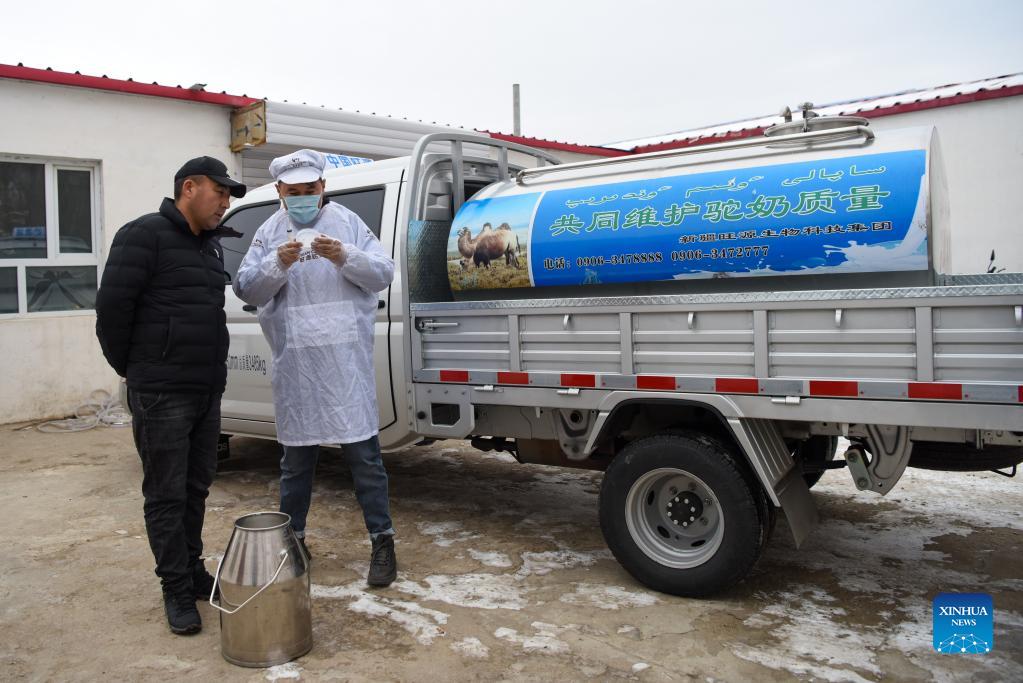
A milk collector checks camel milk quality in Fuhai County of Altay, northwest China's Xinjiang Uygur Autonomous Region, Nov. 26, 2021. Fuhai, located in north Xinjiang, is an important stock farming base in the region, with unique geographical and climatic conditions especially suitable for camel breeding. In recent years, camel breeding has developed into a pillar industry under promotion policy in Fuhai. By establishing camel milk cooperatives, individual herders here are accessing the dairy market through unified and stable sales channels. In 2021, the number of camels in the county has totaled 22,300, among which 6,470 are dairy camels with a daily milk output of 12,500 kilograms. (Xinhua/Ding Lei)
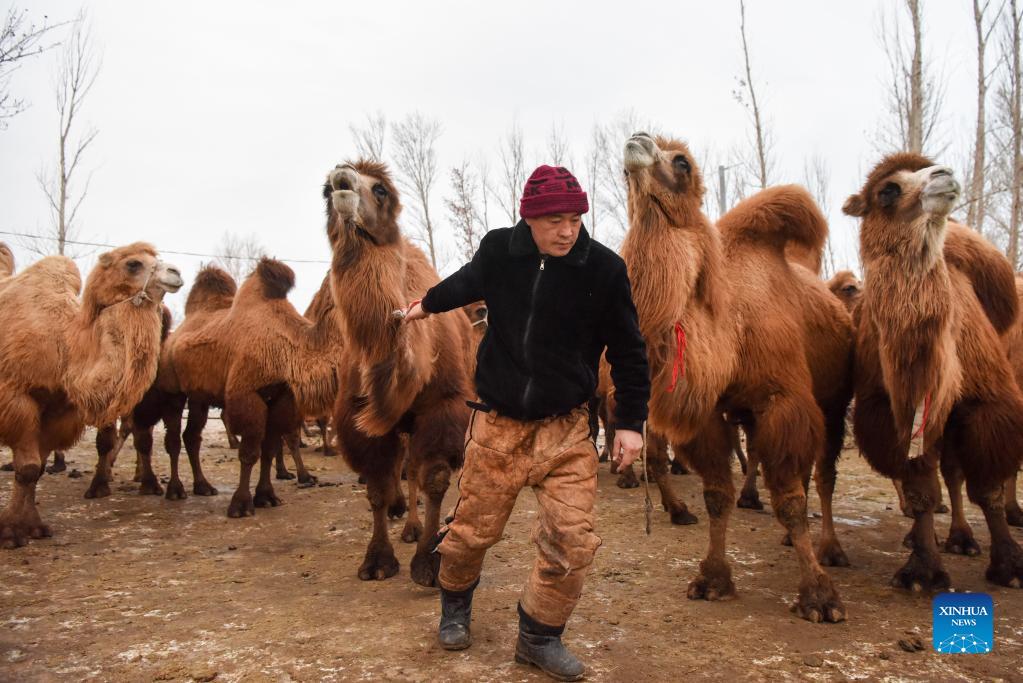
A breeder leads a camel for milking in Fuhai County of Altay, northwest China's Xinjiang Uygur Autonomous Region, Nov. 26, 2021. Fuhai, located in north Xinjiang, is an important stock farming base in the region, with unique geographical and climatic conditions especially suitable for camel breeding. In recent years, camel breeding has developed into a pillar industry under promotion policy in Fuhai. By establishing camel milk cooperatives, individual herders here are accessing the dairy market through unified and stable sales channels. In 2021, the number of camels in the county has totaled 22,300, among which 6,470 are dairy camels with a daily milk output of 12,500 kilograms. (Xinhua/Ding Lei)